First steps in the keep
-
Attach 9volt power supply (+ center) :-smiley-: You can also connect 12volts but 9volts is safer when connecting other devices. 12 volts provides a higher frequency range.
-
Initially, if the mix knob is hard left, you’ll hear only a single tone from the frequency generator. If you don’t hear it, turn the mix knob to the left.
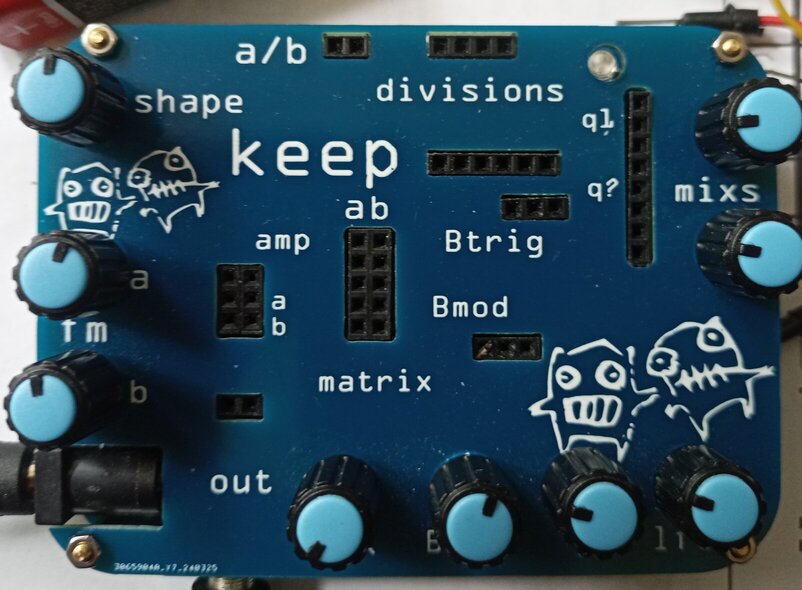
connect?
-
Ok, that’s the A channel of the generator/oscillator. Turn the knob labeled ‘a’ to change the pitch.
-
Now, try the knob labeled ‘shape’. Hard left is a modulated somewhat dirty triangle wave. In the middle is a Sine wave. Almost completely right and you have a ‘clean’ triangle. All the way right and you’ll hear a modulated triangle that’s reasonably ‘clean’.
-
Now it get’s interesting. The LED is indicating at what rate the pulse generator (which serves as a low frequency oscillator, and oscillator) is running. Turn it to hear the rate of the modulation change. Now turn the shape knob back a bit to hear the modulation go away. Set it fairly high (3 pm) to hear changes more easily for the time being.
-
Ok, NOW it get’s interesting. Place a jumper wire from one of the headers under ‘divisions’, say the second one, and connect to a/b. Ah, we have modulation again. This time, it’s the switching between a/b, at a rate that is a division of the primary LFO rate. Try moving the knobs labeled ‘a’ and ‘b’. Oh, we have a two tone melody.
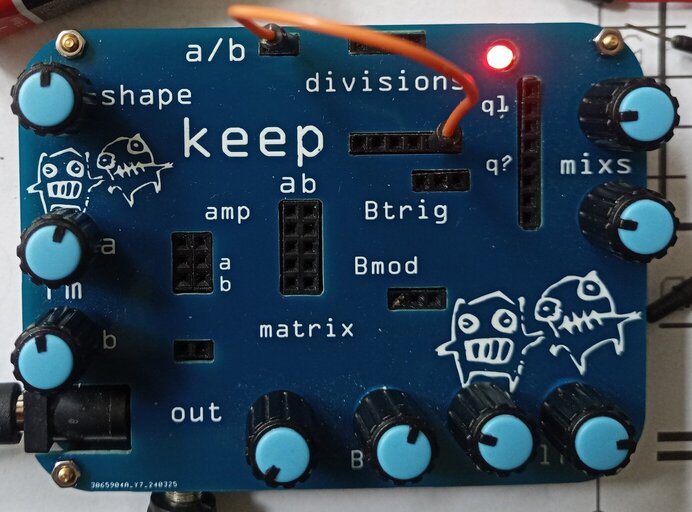
a/b channel switch
- I’m impatient. Let’s see what knob ‘q1’ si about. Connect a jumper from the 4th pin hole down to the ‘a’ column (that’s a mixer column). Oh, now we have a bunch of tones being generated! Yeah! Play with the top right ‘mix’ knob. Hard left, and right and it’s the same as one of the outputs above and below divisions. In between it’s a mix of outputs. In effect, a melody. The top knob is faster subdivisions, the bottom ‘mix’ knob slower. There is also attenuation. We’ll get back to that.
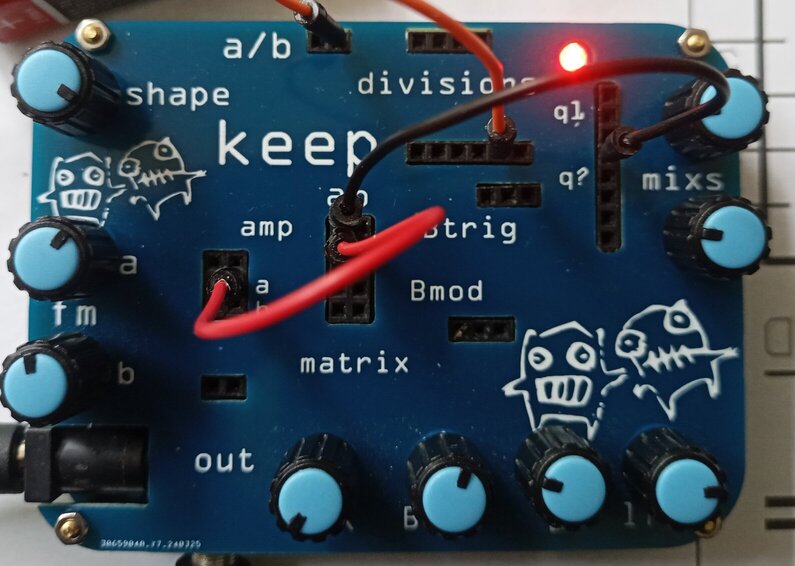
mixs ina mix
-
To see what just that mixed output sounds like on one channel, remove the jumper from a/b (so it’s only playing a without channel switching). Well, that’s pretty complex, already. Hmmm. Let’s simplify.
-
Put the jumper from divisions back to a/b and remove the jumper from ‘q1’. Back to two tones. Place one jumper from a ‘divisions’ output to the ‘a column’. And we have three tones. Play with the a and b knobs. They now exhibit odd behaviour :)

4040 direct sequence with a/b
- Take a jumper from a division output and connect it directly to the ‘b’ input. Ok, you’ve now made a mini-sequence with direct intervals, modifed by the a and b pots. You can also directly connect the a and b inputs, passing the input dirctly. And so produce a more complex melody simply with connects to a/b, a & b and between a and b. Neato :)
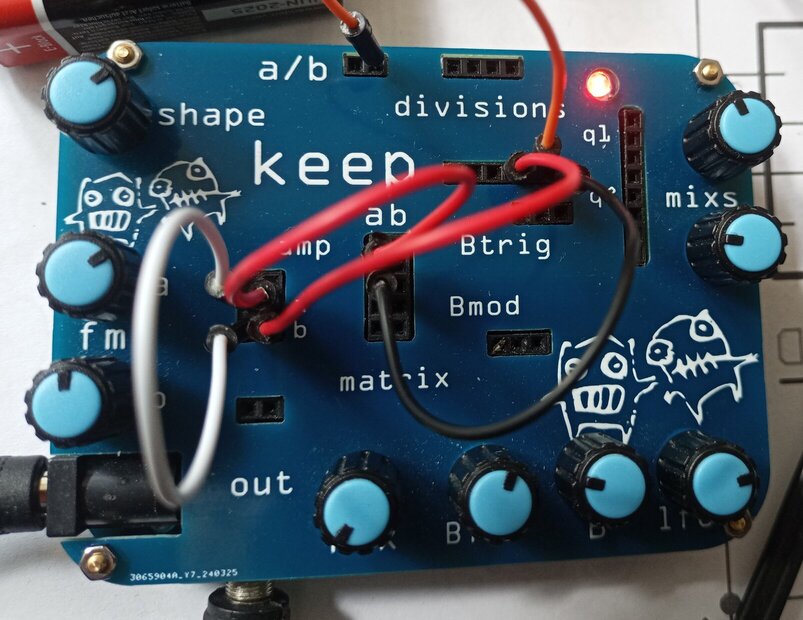
a to b pass the sequnce on
- Disconnect the jumper for the ‘b’ input and connect it to an input directly under ‘amp’. Now you have amplitude (loudness) modulation. Try changing the ‘shape’ knob to get an idea of how extreme or mild the effect is.
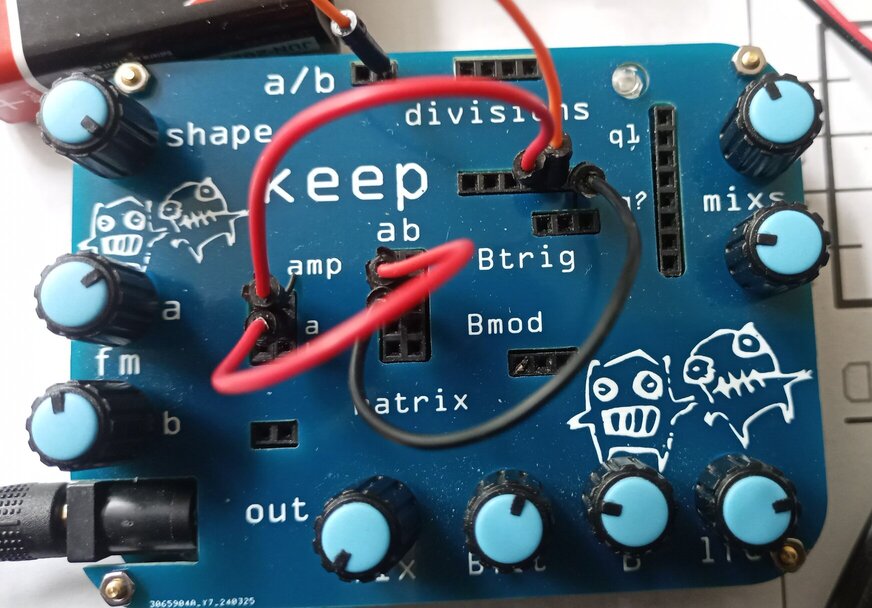
amplitude modulation
- What’s ‘Btrig’? Ok, that’s the pulse wave trigger. You have two oscillators, not just the frequency generator but also a pulse, a bit harsher. Place a connector from the 3rd from left pin under divisions. Turn the knob ‘B’ to about 12 o’clock, ‘Bflt’ hard right and the mix to about 10 o’clock. Oh. It’s a bass thingy. :0 Use Bflt (filter) to dminish the hash edges, but not to much since it’s a very primitive filter that will eat the amplitude as well. Turning the ‘B’ knob will change frequency. It goes very high :) So not necessarily bass, now.

bass section
Ok, that’s the basics :)
- Ok, now do something crazy (optional!)0. Place an electrolytic 1uf capacitor with the positive side in the right ‘output’ pin and the negative side in the ‘b’ column. Now connect a jumper from the ‘b’ colum to the ‘b’ frequency input. See the video on the website :) Isn’t that great!

add crazy.
And now you’ve mastered modular synthesis. :-smiley-:-smile-:
And it might sound like this ….
and the crazy version: